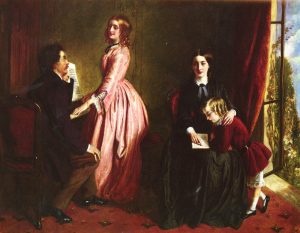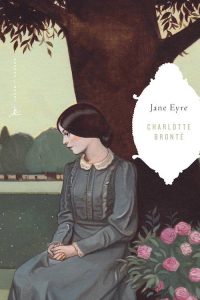In my first blog post I presented the elements of a Victorian Governess Novel and wrote about Charlotte Brontë’s intentions with her famous book, Jane Eyre. I also researched and described the life of real governesses in the Victorian period with the help of M. Jeanne Peterson’s work on the subject. Now I will use the collected data to determine how loyal Jane Eyre is to the Victorian Governess Novels.

The Governess (Rebecca Solomon, circa 1851)
“‘She treats me like a visitor,’ thought I. ‘I little expected such reception; I anticipated only coldness and stiffness: this is not like what I have heard of the treatment of governesses; but I must not exult too soon’” (Chapter 11). This is what Jane narrates after Mrs. Fairfax the housekeeper, whom Jane believes to be the lady of the house at this point, gives her a warm welcome. Jane’s similar remarks about her own beliefs concerning the way governesses are treated – rather than her actual treatment – are the best guides to understanding the life of a governess as I will demonstrate in the next paragraphs.
In my last entry I stated that the only way a gentlewoman could retain her social position and acquire a paying job was through becoming a governess. While harsh judgement was avoided this way, the first step towards getting a job still held dangers of social disapproval. A woman posting an advertisement in need of work was considered disgraceful, and it was attempted only when the lady had no friends who could recommend them to an acquaintance. Jane never explicitly mentions the social dangers in advertising, but she alludes to it by publishing only her initials.
This expectation of the community was only the first unfair moment in the life of the governess. The others that followed came mainly from the house of her employer. The governess was not only charged with teaching her pupil, but she had to fill the roles of the lady companion and the chaperone to the girls under her charge too. These duties left the governess with little to no time to herself, severing her ties with her friends and family. By contrast, for most of her early life, Jane knew only her abusive family and the more sympathetic inhabitants of Lowood Institute. After her childhood friend, Helen Burns dies and after her teacher, later colleague, Miss Temple leaves the school, Jane is left with nobody important in her life – nobody she could lose because of her duties – and feels no isolation at Thornfield Hall.

Jane Eyre in Penguin Random House’s
Modern Library Classics
The social position of the governess in the house was also complicated. As a gentlewoman, she was brought up in a higher social circle than the middle-class family employing her. As a worker paid by the middle class, however, she lost status in their house. The same reason alienated her from the servants too. Possessing higher birth and education placed the governess above the domestics, and this difference between paid workers and their treatment often resulted in antagonism. In Jane Eyre, Mrs. Fairfax addresses this difference in relation to her and Jane, compared to the other servants, saying she is glad for Jane’s company as she often feels alone among the servants: “you see they are only servants, and one can’t converse with them on terms of equality; one must keep them at due distance for fear of losing one’s authority” (Chapter 11). The housekeeper’s position makes Mrs. Fairfax almost Jane’s equal and as Jane interacts with her the most out of all the domestics, she is not faced with distain personally. Thus, this hardship is also mentioned instead of being shown in the novel.
Jane’s relationship with the family she works for also contradicts stereotypical expectations. Occasionally, the pupil had very strong contempt for the governess who taught her and in the worst cases this was visible on the body of a governess in the form of scratches and bruises. In Brontë’s novel the young Adéle admires Jane, so the idea of disrespect and physical abuse is not represented at all.
The same is true of Jane’s relationship with Mr. Rochester. The sexual attraction between the master of the house and the governess could have been probable, but a happy ending was impossible. To avoid distressing situations the gentleman and the governess rarely conversed. To help keep the proper conduct the governess was desexualized, masculinized as much as possible. In opposition to this, in Jane Eyre Mr. Rochester willingly summons Jane to ask her opinion and even reveals his sexual life to her.
After comparing these facts presented by M. Jeanne Peterson and Charlotte Brontë’s novel, I came to the conclusion that Jane Eyre is not a Victorian Governess Novel, despite the occupation of the heroine. But while Jane’s tale is more of a personal story, Charlotte Brontë was not oblivious to the harmful aspects of a governess’s life: the remarks Jane silently makes reflect upon the impossibility of the happy ending she gains.
“The Victorian Governess: Status Incongruence in Family and Society”
by M. Jeanne Peterson on JSTOR
For image sources, see:
Jane Eyre covers (Everyman’s Library; Modern Library Classics by Penguin Random House) on Book Riot


